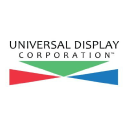/ factorpad.com / stocks / f75dsr.html
An ad-free and cookie-free website.
Our quantitative data points are meant to provide a high-level understanding of factors in equity risk models for Universal Display Corp. Portfolio managers use these models to forecast risk, optimize portfolios and review performance.
We show how OLED stock compares to 2,000+ US-based stocks, and to peers in the Manufacturing sector and Semiconductor and Related Device Manufacturing industry.
Please do not consider this data as investment advice. Data is downloaded from sources we deem reliable, but errors may occur.
 Universal Display Corporation is a leader in the research, development and commercialization of organic light emitting diode (OLED) technologies and materials for use in display, solid-state lighting applications with subsidiaries and offices around the world. Founded in 1994, the Company currently owns, exclusively licenses or has the sole right to sublicense more than 5,000 patents issued and pending worldwide. Universal Display licenses its proprietary technologies, including its breakthrough high-efficiency UniversalPHOLED® phosphorescent OLED technology that can enable the development of energy-efficient and eco-friendly displays and solid-state lighting. The Company also develops and offers high-quality, state-of-the-art UniversalPHOLED materials that are recognized as key ingredients in the fabrication of OLEDs with peak performance. In addition, Universal Display delivers innovative and customized solutions to its clients and partners through technology transfer, collaborative technology development and on-site training.
Universal Display Corporation is a leader in the research, development and commercialization of organic light emitting diode (OLED) technologies and materials for use in display, solid-state lighting applications with subsidiaries and offices around the world. Founded in 1994, the Company currently owns, exclusively licenses or has the sole right to sublicense more than 5,000 patents issued and pending worldwide. Universal Display licenses its proprietary technologies, including its breakthrough high-efficiency UniversalPHOLED® phosphorescent OLED technology that can enable the development of energy-efficient and eco-friendly displays and solid-state lighting. The Company also develops and offers high-quality, state-of-the-art UniversalPHOLED materials that are recognized as key ingredients in the fabrication of OLEDs with peak performance. In addition, Universal Display delivers innovative and customized solutions to its clients and partners through technology transfer, collaborative technology development and on-site training.
Many of the following risk metrics are standardized and transformed into quantitative factors in institutional-level risk models.
Rankings below represent percentiles from 1 to 100, with 1 being the lowest rating of risk.
Stocks with higher beta exhibit higher sensitivity to the ups and downs in the market. (↑↑)
Stocks with higher market capitalization often have lower risk. (↑↓)
Higher average daily dollar volume over the past 30 days implies lower liquidity risk. (↑↓)
Higher price momentum stocks, aka recent winners, equate to lower risk for many investors. (↑↓)
Style risk factors often include measures of profitability and payout levels.
Companies with higher earnings generally provide lower risk. (↑↓)
Companies with higher dividend yields, if sustaintable, are perceived to have lower risk. (↑↓)
/ factorpad.com / stocks / f75dsr.html
A newly-updated free resource. Connect and refer a friend today.